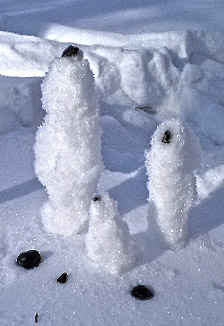It looks as though we've been beaten to it and Graham's hunch was correct....
Mysterious 'snow carrots' observed at meteorite impact sites.
Initially, researchers had speculated that the carrot shapes may have been caused by hot fragments that melted the snow during the impact, but the simulations showed that the fragments would have had ample time to cool to atmospheric temperatures before reaching the ground. Instead, the strange funnels appear to be formed mostly by mechanical forces. In the first phase of the impact, a rounded crater is formed, and the snow beneath the rock is compressed, causing its density to increase. Over the next 10 milliseconds, the denser snow gradually slows the meteorite and the walls of the funnel narrow accordingly.
The source paper is being presented at The 46th Lunar and Planetary Science Conference (2015).
Snow Compaction During The Chelyabinsk Meteorite Fall, by Luther, Lukashin, Artemieva. Shuvalov and Wünnemann.
I'm not convinced by figure 2, which seems to suggests a 1kg, partially melted fragment, reaching thermal equilibrium, as it falls through the atmosphere, in under ten seconds. That seems a bit short, but I guess it does pass through a lot of atmosphere in those ten seconds. From the videos, of recovery, I'd seen, I'd thought the icy core was beneath the recovered meteorite. The paper and, to be fair, the
Sky and Telescope article has the meteorite at the bottom of the icy part.

